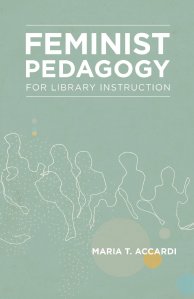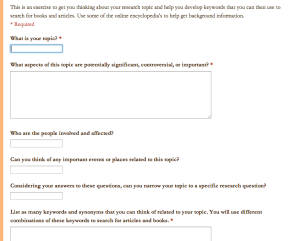“What was your first feminist experience?” This question was first posed to me as an ACRL conference session attendee, where I saw Maria Accardi, Emily Drabinski and Alana Kumbier present Imagining the Future of Library Instruction: How Feminist Pedagogy Can Transform the Way You Teach and How Students Learn. Going in, I did not know much about what feminist pedagogy was but as I learned about it, I saw very practical ways in which I could incorporate this approach to my own instruction sessions. Currently, I am enrolled in a Feminist Pedagogy class taught by Maria Accardi and really enjoying it so far. The class has been reading her book Feminist Pedagogy For Library Instruction, where Accardi weaves in personal narrative, theory, and practical examples.
For those who want a definition of what feminist pedagogy is, Accardi discusses in her book that there is no clear definition. However, there are several themes that run through the feminist pedagogy literature, like “classroom as a collaborative, democratic, transformative site; consciousness raising about sexism and oppression; and the value of personal testimony and lived experience as valid ways of knowing.” (pg. 35) Tying it into library instruction, she gives examples of using active learning, group work, and the example of using search examples that highlight social injustices to students. For example, using the search terms “women in engineering” will show results that include articles that discuss the difficulties women face in those fields (p. 37).
Reading through the book, I was reminded of a time when a student approached the reference desk and asked me to help her find books about homosexuality. She said she didn’t know how she “felt about it” and wanted some information that would perhaps sway her to think that it was either right or wrong. As an LGBT ally, I found her objective information about the LGBT community and encouraged her to base her opinions on the research, not just what an authority figure would tell her to think. Accardi mentions that feminism is concerned with not just sexism, but other social justice issues as well. I think many people can relate to being in a situation like the one I described. I was taught in my reference class that the reference librarian is supposed to be neutral, and not interject my own personal beliefs in my transactions, but from reading Accardi’s book, I am beginning to think that it’s more important to encourage students to be critical thinkers. While I can’t outright tell a student, I don’t agree with their opinion, I can help them find information and encourage them to consider all of the viewpoints.
Last week, I incorporated feminist pedagogy into a few of my library instruction sessions. The classes were for a first year english composition course, where their research focus was on sanitation and sewage. I had taken for granted that people even did research on sewage. I was wondering how I would approach this class at all, and how would I make it feminist? In a one-shot session, there’s always pressure to impart all everything you can to make sure the students leave with solid research skills. Realistically, they are overwhelmed and can’t absorb everything you tell them. As discussed earlier, feminist pedagogy values collaboration and active learning; which helps to engage the students so that they will hopefully remember more. With that in mind, I started off the session with having the class brainstorm keywords related to a research question. My example question was “how does gender impact bathroom designs?” This question was trying to get students to consider how gender does change bathroom design.
Then, I had the students break up into groups to work on a topic development exercise. My department has been experimenting with Google Forms for assessment. In the past, students have tended to fill out these forms individually; but in these sessions I asked that the groups designate one person to be the typist, and the others to help brainstorm and research. I noticed that the students were really engaged right away. I think getting them to talk to each other about the topic, helped them brainstorm, and also explore library resources to help them build on their vocabulary. After they finished up, I showed them the backend of the form, and used some of their examples to demonstrate looking for articles on their research topics.
What exactly about this activity is feminist? In Accardi’s book, she details how feminist library classroom use activities that encourage collaboration and group work, use examples that highlight social injustice, talk about synonyms can show how certain terms fail to describe marginalized groups. I think many people may find that they already do these things in their own instruction, which makes it much easier for librarians to incorporate feminist pedagogy into the classroom. I could probably ramble on and on about this, so I just highly recommend reading the book. It’s not too long, has tons of information, practical examples, and has transformed the way that I approach my own instruction. Accardi really makes the best argument for feminist pedagogy when she says:
…the marginal status of librarians gives us more freedom to experiment with our pedagogy than regular teaching faculty have, especially if we are not bound by the strictures of the credit-bearing information literacy course. While the one-shot class has its own set of challenges, it also has more flexibility that progressive librarians can take advantage of and subvert for progressive purposes. (p.69)
You can buy her book on Amazon, read Nicole Pagowsky’s post, and find out more about feminist pedagogy here.
[Semi-formally citing: Accardi, M. T. (2013). Feminist pedagogy for library instruction. Sacramento, CA: Library Juice Press.]


Pingback: Libraries need a feminist agenda…but which one? | Sense & Reference
Pingback: Research as a Conversation and Feminist Pedagogy | cat lady librarian
Pingback: Resena-FemistPedagogyforLibraryInstruction
Pingback: Items about books I want to read, #50 | Alchemical Thoughts